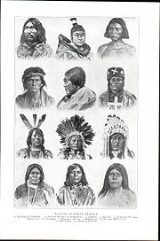
Population history of American indigenous peoples
Overview
The population figures for Indigenous peoples in the Americas
before the 1492 voyage of Christopher Columbus
have proven difficult to establish and rely on archaeological data and written records from European settlers. Most scholars writing at the end of the 19th century estimated the pre-Columbian
population at about 10 million; by the end of the 20th century the scholarly consensus had shifted to about 50 million, with some arguing for 100 million or more.
Indigenous peoples of the Americas
The indigenous peoples of the Americas are the pre-Columbian inhabitants of North and South America, their descendants and other ethnic groups who are identified with those peoples. Indigenous peoples are known in Canada as Aboriginal peoples, and in the United States as Native Americans...
before the 1492 voyage of Christopher Columbus
Christopher Columbus
Christopher Columbus was an explorer, colonizer, and navigator, born in the Republic of Genoa, in northwestern Italy. Under the auspices of the Catholic Monarchs of Spain, he completed four voyages across the Atlantic Ocean that led to general European awareness of the American continents in the...
have proven difficult to establish and rely on archaeological data and written records from European settlers. Most scholars writing at the end of the 19th century estimated the pre-Columbian
Pre-Columbian
The pre-Columbian era incorporates all period subdivisions in the history and prehistory of the Americas before the appearance of significant European influences on the American continents, spanning the time of the original settlement in the Upper Paleolithic period to European colonization during...
population at about 10 million; by the end of the 20th century the scholarly consensus had shifted to about 50 million, with some arguing for 100 million or more.
Unanswered Questions

